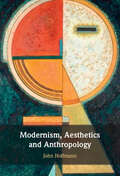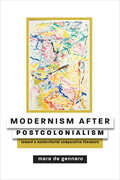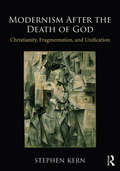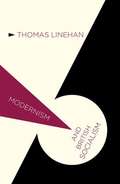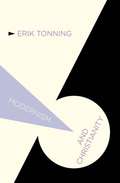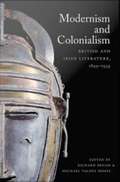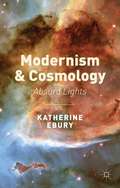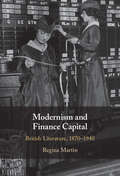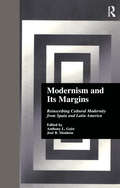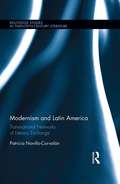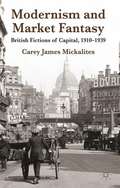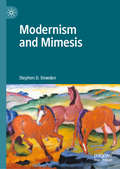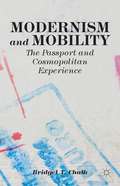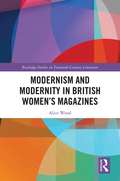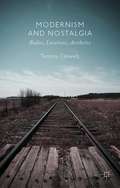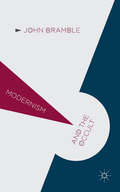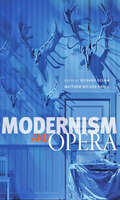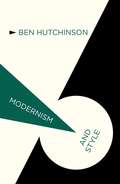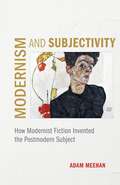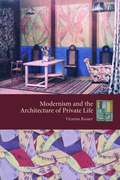- Table View
- List View
Modernism, Aesthetics and Anthropology
by John HoffmannJohn Hoffmann argues that a combination of aesthetics and anthropology allowed modernist writers to challenge social hierarchies they associated with the nineteenth century. He shows how Enlightenment philosophers synthesized the two discourses and how modernists working in the early twentieth century then took up this synthesis to dispute categories of social difference that had been naturalized, and thus legitimized, by pre-evolutionary and Darwinian anthropological theories. The book brings a range of new insights to major topics in modernist studies, revealing neglected continental sources for Irish anti-colonialism, the aesthetic contours of Zionism in the era of Mandatory Palestine, and the influence of German idealism on critiques of racism following World War I. Working over a long historical durée, Hoffmann surveys the ways aesthetics has been used, and misused, to construct and contest social hierarchies grounded in anthropological distinctions.
Modernism after Postcolonialism: Toward a Nonterritorial Comparative Literature (Hopkins Studies in Modernism)
by Mara de GennaroA polemical reaction against a trend in global modernist studies which still privileges European and Anglophone texts.Existing studies of literary modernism generally read Anglophone Atlantic texts through the lens of critical theories emanating from Europe and North America. In Modernism after Postcolonialism, Mara de Gennaro undertakes a comparative Anglophone-Francophone study, invoking theoretical frameworks from Gayatri Spivak, Édouard Glissant, Françoise Vergès, Michel-Rolph Trouillot, Dipesh Chakrabarty, and others. Examining transnational poetics of comparison that contest the comparative practices of colonialist, racist, and ethno-nationalist discourses, the book treats these poetics as models for a creolist critical method of reading, one that searches out unpredictable, mutually generative textual relations obscured by geographic and linguistic divides. In each chapter, de Gennaro pairs a canonical English-language modernist writer (Gertrude Stein, T. S. Eliot, E. M. Forster, Virginia Woolf) with a postcolonial writer (Aimé Cesaire, Glissant, Patrick Chamoiseau, J. M. Coetzee, Edwidge Danticat), interpreting major works of prewar and interwar modernism in light of postcolonial and Francophone literature, cultural theory, and historiography. Read together, these texts suggest a turn—sometimes subtle or conflicted in earlier Atlantic modernist texts, while usually more overt in later Caribbean and postcolonial texts—toward comparative forms marked by irresolution and a wavering sense of authority. With the rise of world literature and global modernist studies, it becomes all the more pressing to examine how comparative forms can alert us to unspoken and misrecognized relations while also confronting us with the difficulty of representing the Other.By bringing into relation these ostensibly unconnected, often discrepant texts, de Gennaro challenges entrenched territorial habits of literary meaning. An aspirationally nonterritorial comparative literature, she argues, diverges not only from Eurocentric formalist approaches but also from global comparatisms that emphasize incommensurabilities to the point of eliding significant textual and contextual connections. Drawing on interdisciplinary postcolonial efforts, especially in the social sciences, to deterritorialize categories of identity, culture, and community, Modernism after Postcolonialism dispenses with outdated modernist and postcolonial paradigms to reveal how the anxious, inconclusive comparisons of transnational modernist poetics can call us to imagine new solidarities across bounded territories.
Modernism After the Death of God: Christianity, Fragmentation, and Unification
by Stephen KernModernism After the Death of God explores the work of seven influential modernists. Friedrich Nietzsche, James Joyce, D. H. Lawrence, André Gide, and Martin Heidegger criticized the destructive impact that they believed Christian sexual morality had had or threatened to have on their love life. Although not a Christian, Freud criticized the negative effect that Christian sexual morality had on his clinical subjects and on Western civilization, while Virginia Woolf condemned how her society was sanctioned by a patriarchal Christian authority. All seven worked to replace the loss or absence of Christian unity with non-Christian unifying projects in their respective fields of philosophy, psychiatry, or literature. The basic structure of their main contributions to modernist culture was a dynamic interaction of radical fragmentation necessitating radical unification that was always in process and never complete.
Modernism and Autobiography
by Maria Dibattista Emily O. WittmanThis volume offers sixteen original essays that attest to the extraordinary inventiveness and range of modernist autobiography. It examines the ways modernist writers chose to tell their life stories, with particular attention to forms, venues, modes of address, and degrees of truthfulness. The essays are grouped around a set of rubrics that isolate the distinctive character and shared preoccupations of modernist life-writings: questions of ancestry and tradition that foreground the modernists' troubled relation to their immediate familial as well as cultural past; their emergence as writers whose experiences found expression in untraditional and singular forms; their sense of themselves as survivors of personal and historical traumas; and their burdens as self-chroniclers of loss, especially of self-loss. It will appeal especially to scholars and students of literary modernism and English literature more generally.
Modernism and British Socialism
by Thomas LinehanThomas Linehan offers a fresh perspective on late Victorian and Edwardian socialism by examining the socialist revival of these years from the standpoint of modernism. In so doing, he explores the modernist mission as extending beyond the concerns of the literary and artistic avant-garde to incorporate political and social movements.
Modernism and Christianity
by Erik TonningBy theorising the idea of 'formative tensions' between cultural Modernism and Christianity, and by in-depth case studies of James Joyce, David Jones, T. S. Eliot, Ezra Pound, W. H. Auden, Samuel Beckett, the book argues that no coherent account of Modernism can ignore the continuing impact of Christianity.
Modernism and Colonialism: British and Irish Literature, 1899-1939
by Richard Begam Michael Valdez MosesThis collection of essays by renowned literary scholars offers a sustained and comprehensive account of the relation of British and Irish literary modernism to colonialism. Bringing postcolonial studies into dialogue with modernist studies, the contributors move beyond depoliticized appreciations of modernist aesthetics as well as the dismissal of literary modernism as irredeemably complicit in the evils of colonialism. They demonstrate that the modernists were not unapologetic supporters of empire. Many were avowedly and vociferously opposed to colonialism, and all of the writers considered in this volume were concerned with the political and cultural significance of colonialism, including its negative consequences for both the colonizer and the colonized. Ranging over poetry, fiction, and criticism, the essays provide fresh appraisals of Joseph Conrad, T. S. Eliot, Ezra Pound, Virginia Woolf, D. H. Lawrence, Wyndham Lewis, E. M. Forster, W. B. Yeats, James Joyce, Elizabeth Bowen, Hugh MacDiarmid, and Evelyn Waugh, as well as Robert Louis Stevenson and H. Rider Haggard. The essays that bookend the collection connect the modernists to their Victorian precursors, to postwar literary critics, and to postcolonial poets. The rest treat major works written or published between 1899 and 1939, the boom years of literary modernism and the period during which the British empire reached its greatest geographic expanse. Among the essays are explorations of how primitivism figured in the fiction of Lawrence and Lewis; how, in Ulysses, Joyce used modernist techniques toward anticolonial ends; and how British imperialism inspired Conrad, Woolf, and Eliot to seek new aesthetic forms appropriate to the sense of dislocation they associated with empire. Contributors. Nicholas Allen, Rita Barnard, Richard Begam, Nicholas Daly, Maria DiBattista, Ian Duncan, Jed Esty, Andrzej Gąsiorek, Declan Kiberd, Brian May, Michael Valdez Moses, Jahan Ramazani, Vincent Sherry
Modernism and Cosmology
by Katherine EburyThrough examining the work of W. B. Yeats, James Joyce, and Samuel Beckett, Katherine Ebury shows cosmology had a considerable impact on modernist creative strategies, developing alternative reading models of difficult texts such as Finnegans Wake and 'The Trilogy'.
Modernism and Finance Capital: British Literature, 1870–1940
by Regina MartinModernism and Finance Capital interprets modernism as a historical moment of financial crisis. It expands the definition of finance capital beyond mode of capital accumulation and value form to include a complex of historical processes during the modernist period, which includes the growth of the professional classes, the rise of the modern corporation, the economic turn toward London, and the emergence of affect as economic and literary value form. The book thereby locates the origins of twenty-first century affective economy in the turn-of-the-twentieth century modernist and financial revolutions. Scholars working at the crossroads of economic and cultural studies will find a model for how to interpret literature and other cultural artifacts as participating in economic processes of finance capital even when they do not engage explicitly with such issues.
Modernism and Its Margins: Reinscribing Cultural Modernity from Spain and Latin America (Hispanic Issues)
by Anthony L. Geist José B. MonleónThis volume represents a rereading of modernism and the modernist canon from a double distance: geographical and temporal. It is a revision not only from the periphery (Spain and Latin America), but from this new fin de si cle as well, a revisiting of modernity and its cultural artifacts from that same postmodernity. Modernism and Its Margins is an attempt at introducing different perspectives and examples in the theoretical debate, redefine dominant assumptions of what modernism-or margins-mean in our historical juncture.
Modernism and Japanese Culture
by Roy StarrsAn in-depth and comprehensive account of the complex history of Japanese modernism from the mid-19th century 'opening to the West' until the 21st century globalized world of 'postmodernism. ' Its concept of modernism encompasses not just the aesthetic avant-garde but a wide spectrum of social, political and cultural phenomena.
Modernism and Latin America: Transnational Networks of Literary Exchange (Routledge Studies in Twentieth-Century Literature)
by Patricia Novillo-CorvalánThis book is the first in-depth exploration of the relationship between Latin American and European modernisms during the long twentieth century. Drawing on comparative, historical, and postcolonial reading strategies (including archival research), it seeks to reenergize the study of modernism by putting the spotlight on the cultural networks and aesthetic dialogues that developed between European and non-European writers, including Pablo Neruda, James Joyce, Leonard Woolf, Virginia Woolf, Jorge Luis Borges, Victoria Ocampo, Roberto Bolaño, Julio Cortázar, Samuel Beckett, Octavio Paz, Carlos Fuentes, and Malcolm Lowry. The book explores a wide range of texts that reflect these writers’ complex concerns with questions of exile, space, empire, colonization, reception, translation, human subjectivity, and modernist experimentation. By rethinking modernism comparatively and by placing this intricate web of cultural interconnections within an expansive transnational (and transcontinental) framework, this unique study opens up new perspectives that delineate the construction of a polycentric geography of modernism. It will be of interest to those studying global modernisms, as well as Latin American literature, transatlantic studies, comparative literature, world literature, translation studies, and the global south.
Modernism and Market Fantasy
by Carey James MickalitesExamining work from Ford and Conrad's pre-war impressionism through Rhys's fiction of the late 1930s, the author shows how modernist innovation engages with transformations in early twentieth-century capitalism and tracks the ways in which modernist fiction reconfigures capitalist mythologies along the fault lines of their internal contradictions.
Modernism and Masculinity
by Natalya Lusty Julian MurphetModernism and Masculinity investigates the varied dimensions and manifestations of masculinity in the modernist period. Thirteen essays from leading scholars reframe critical trends in modernist studies by examining distinctive features of modernist literary and cultural work through the lens of masculinity and male privilege. The volume attends to masculinity as an unstable horizon of gendered ideologies, subjectivities and representational practices, allowing for fresh interdisciplinary treatments of celebrated and lesser-known authors, artists and theorists such as D. H. Lawrence, Ezra Pound, Henry Roth, Theodor Adorno and Paul Robeson as well as modernist avant-garde movements such as vorticism, surrealism and futurism. As diverse as the masculinities that were played out across the early twentieth century, the approaches and arguments featured in this collection will appeal especially to scholars and students of modernist literature and culture, gender studies and English literature more broadly.
Modernism and Mimesis
by Stephen D. DowdenThis book offers a bold new view of the way in which modernist fiction, painting, music, and poetry are interlinked. Dowden shows that modernism, contrary to a longstanding view, did not turn away from mimesis. Rather, modernism operates according to a deepened understanding of what mimesis is and how it works, which in turn occasions a fresh look at other related dimensions of the modernist achievement. Modernism is neither “difficult” nor elitist. Instead, it trends toward simplicity, directness, and common culture. Dowden argues that naïveté rather than highbrow sophistication was for the modernists a key artistic principle. He demonstrates that modernism, far from glorifying subjective creativity, directs itself toward healing the split between subject and object. Mimesis closes this gap by resolving representation into play and festivity.
Modernism and Mobility
by Bridget T. ChalkTracing the changing conceptions of nationality in the work of traveling writers such as D. H. Lawrence, Gertrude Stein, and Claude McKay, Modernism and Mobility argues that the passport system is an indispensable segue into discussions of literary modernism.
Modernism and Modernity in British Women’s Magazines (Routledge Studies in Twentieth-Century Literature)
by Alice WoodThis book explores responses to the strangeness and pleasures of modernism and modernity in four commercial British women’s magazines of the interwar period. Through extensive study of interwar Vogue (UK), Eve, Good Housekeeping (UK), and Harper’s Bazaar (UK), Wood uncovers how modernism was received and disseminated by these fashion and domestic periodicals and recovers experimental journalism and fiction within them by an array of canonical and marginalized writers, including Storm Jameson, Rose Macaulay, Gertrude Stein, and Virginia Woolf. The book’s analysis is attentive to text and image and to interactions between editorial, feature, and advertising material. Its detailed survey of these largely neglected magazines reveals how they situated radical aesthetics in relation to modernity’s broader new challenges, diversions, and opportunities for women, and how they approached high modernist art and literature through discourses of fashion and celebrity. Modernism and Modernity in British Women’s Magazines extends recent research into modernism’s circulation through diverse markets and publication outlets and adds to the substantial body of scholarship concerned with the relationship between modernism and popular culture. It demonstrates that commercial women’s magazines subversively disrupted and sustained contemporary hierarchies of high and low culture as well as actively participating in the construction of modernism’s public profile.
Modernism and Naturalism in British and Irish Fiction, 1880-1930
by Simon JoyceThis book argues that the history of literary modernism is inextricably connected with naturalism. Simon Joyce traces a complex response among aesthetes to the work of Émile Zola at the turn of the century, recovering naturalism's assumed compatibility with impressionism as a central cause of their ambivalence. Highlighting a little-studied strain of reflexive naturalism in which Zola's mode of analytical observation is turned upon the authors themselves, Joyce suggests that the confluence of naturalism and impressionism formed the precondition for so-called stream-of-consciousness writing. This style served to influence not only the work of canonical modernists such as Joyce and Woolf but also that of lesser-known writers such as George Moore, Sarah Grand, and George Egerton.
Modernism and Nostalgia
by Tammy ClewellThis book addresses the multiple meanings of nostalgia in the literature of the period. Whether depicted as an emotion, remembrance, or fixation, these essays demonstrate that the nostalgic impulse reveals how deeply rooted in the damaged, the old, and the vanishing, were the variety of efforts to imagine and produce the new the distinctly modern. "
Modernism and The Occult
by John BrambleThis study of modernism's high imperial, occult-exotic affiliations presents many well-known figures from the period 1880-1960 in a new light. Modernism and the Occult traces the history of modernist engagement with 'irregular', heterodox and imported knowledge.
Modernism and Opera (Hopkins Studies in Modernism)
by Richard Begam and Matthew Wilson SmithMany of the greatest works in the operatic repertoire bear the hallmarks of modernism.At first glance, modernism and opera may seem like strange bedfellows—the former hostile to sentiment, the latter wearing its heart on its sleeve. And yet these apparent opposites attract: many operas are aesthetically avant-garde, politically subversive, and socially transgressive. From the proto-modernist strains of Richard Wagner’s Parsifal through the twenty-first-century modernism of Kaija Saariaho’s L’amour de loin, the duet between modernism and opera, at turns harmonious and dissonant, has been one of the central artistic events of modernity. Despite this centrality, scholars of modernist literature only rarely venture into opera, and music scholars generally return the favor by leaving literature to one side. But opera, that grand cauldron of the arts, demands that scholars, too, share the stage with one another.In Modernism and Opera, Richard Begam and Matthew Wilson Smith bring together musicologists, literary critics, and theater scholars for the first time in a mutual endeavor to trace certain key moments in the history of modernism and opera. This innovative volume includes essays from some of the most notable scholars in their fields and covers works as diverse as Debussy’s Pelléas et Mélisande, Bartók’s Bluebeard’s Castle, Berg’s Wozzeck, Janáček’s Makropulos Case, Thomson’s Four Saints in Three Acts, Strauss’s Arabella, Schoenberg’s Moses und Aron, Stravinsky’s The Rake’s Progress, Britten’s Gloriana, and Messiaen’s Saint François d’Assise. A collaborative study of the ultimate collaborative art form, Modernism and Opera reveals how modernism and opera illuminate each other and, more generally, the culture of the twentieth century. It also addresses a number of issues crucial for understanding the relation between modernism and opera, focusing in particular on intermediality (how modernism integrates music, literature, and drama into opera) and anti-theatricality (how opera responds to modernism’s apparent antipathy to theatricality). This captivating book—the first of its kind—will appeal to scholars of literature, music, theater, and modernity as well as to sophisticated opera lovers everywhere.
Modernism and Style
by Ben HutchinsonModernism is fundamentally determined by its relationship to its own notions of style: oscillating between the poles of 'pure' style and 'purely' style, this traces the stylistic self-conceptualization of modernism from Schopenhauer and Flaubert in the 1850s, through Nietzsche and the symbolists in the 1880s, to the high modernists of the 1920s.
Modernism and Subjectivity: How Modernist Fiction Invented the Postmodern Subject
by Adam MeehanIn Modernism and Subjectivity: How Modernist Fiction Invented the Postmodern Subject, Adam Meehan argues that theories of subjectivity coming out of psychoanalytic, poststructuralist, and adjacent late-twentieth-century intellectual traditions had already been articulated in modernist fiction before 1945. Offering a bold new genealogy for literary modernism, Meehan finds versions of a postmodern subject embodied in works by authors who intently undermine attempts to stabilize conceptions of identity and who draw attention to the role of language in shaping conceptions of the self. Focusing on the philosophical registers of literary texts, Meehan traces the development of modernist attitudes toward subjectivity, particularly in relation to issues of ideology, spatiality, and violence. His analysis explores a selection of works published between 1904 and 1941, beginning with Joseph Conrad’s prescient portrait of the subject interpolated by ideology and culminating with Samuel Beckett’s categorical disavowal of the subjective “I.” Additional close readings of novels by F. Scott Fitzgerald, Aldous Huxley, James Joyce, Nathanael West, and Virginia Woolf establish that modernist texts conceptualize subjectivity as an ideological and linguistic construction that reverberates across understandings of consciousness, race, place, and identity. By reconsidering the movement’s function and scope, Modernism and Subjectivity charts how profoundly modernist literature shaped the intellectual climate of the twentieth century.
Modernism and the Aesthetics of Violence
by Paul SheehanThe notion that violence can give rise to art - and that art can serve as an agent of violence - is a dominant feature of modernist literature. In this study Paul Sheehan traces the modernist fascination with violence to the middle decades of the nineteenth century, when certain French and English writers sought to celebrate dissident sexualities and stylized criminality. Sheehan presents a panoramic view of how the aesthetics of transgression gradually mutates into an infatuation with destruction and upheaval, identifying the First World War as the event through which the modernist aesthetic of violence crystallizes. By engaging with exemplary modernists such as Joyce, Conrad, Eliot, and Pound, as well as lesser-known writers including Gautier, Sacher-Masoch, Wyndham Lewis and others, Sheehan shows how artworks, so often associated with creative well-being and communicative self-expression, can be re-oriented toward violent and bellicose ends.
Modernism and the Architecture of Private Life (Gender and Culture Series)
by Victoria RosnerModernism and the Architecture of Private Life offers a bold new assessment of the role of the domestic sphere in modernist literature, architecture, and design. Elegantly synthesizing modernist literature with architectural plans, room designs, and decorative art, Victoria Rosner's work explores the collaborations among modern British writers, interior designers, and architects in redefining the form, function, and meaning of middle-class private life. Drawing on a host of previously unexamined archival sources and works by figures such as E. M. Forster, Roger Fry, Oscar Wilde, James McNeill Whistler, and Virginia Woolf, Rosner highlights the participation of modernist literature in the creation of an experimental, embodied, and unstructured private life, which we continue to characterize as "modern."
